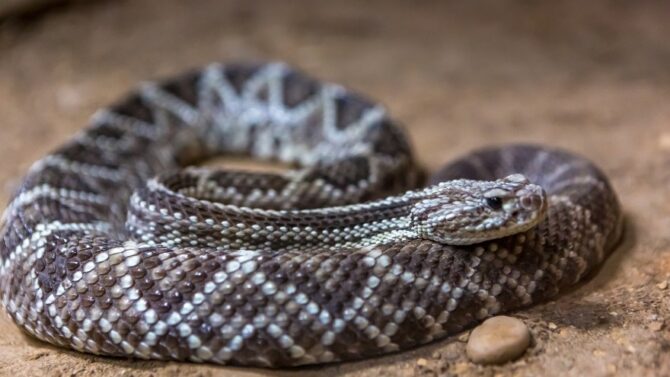The United States is a beautiful country with a wide range of landscapes and ecosystems.
It has some of the most diverse wildlife in the world, with over 400 species of mammals and 50 species of venomous snakes.
From the smallest squirrels to huge grizzly bears, America is home to many animals.
However, there are some dangerous animals in the US that will attack you if you get too close to them. They include mountain lions, black widow spiders, scorpions, sharks, etc.
This article provides insights into 15 of the most dangerous animals you should avoid in the US, as well as safety tips for exploring wildlife in the area.
What are the Most Dangerous Animals in the United States?
1. Cougar (a.k.a. Puma or Mountain Lion)
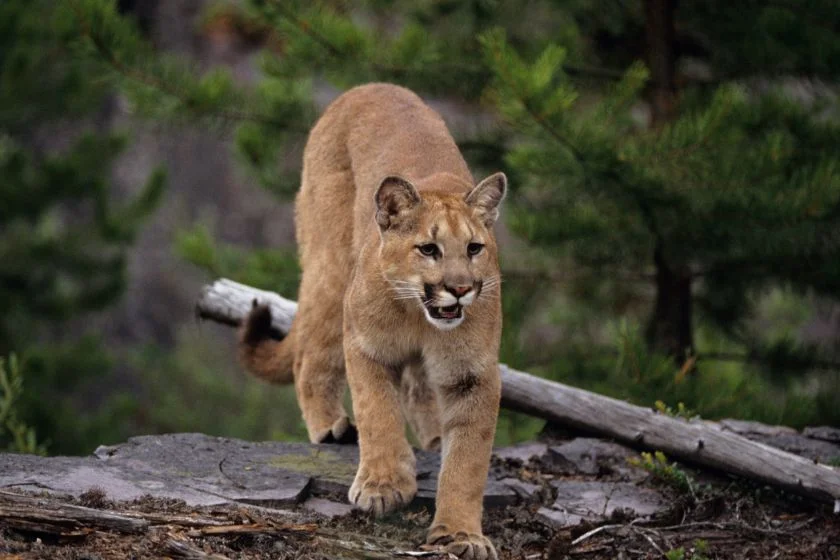
- Scientific name: Felis concolor
- Classification: Mammal
- Habitat: Forest, mountain, swamp, grasslands
- Diet: Carnivore
- Conservation status: Least Concern
Cougar—also known as puma or mountain lion—is the second largest cat in North America, with one of the most powerful bites and paw strength.
An adult cougar can weigh up to 64-198 lbs. and grow up to 5-9 ft.
They are superior hunters that can leap up to 20ft into the air, making it easy for them to grab prey from a distance.
These solitary nocturnal animals are not aggressive as they rarely attack humans. However, they will do so if they feel threatened.
They will consider any threat an enemy and will want to prove they should not be messed with.
Over the years, there have been several cougar attacks. A cougar recently attacked and killed a mountain biker in Washington state, making it over 27 fatalities.
However, people have survived a cougar attack like the Colorado runner who killed it in self-defense.
2. Timber Rattlesnake
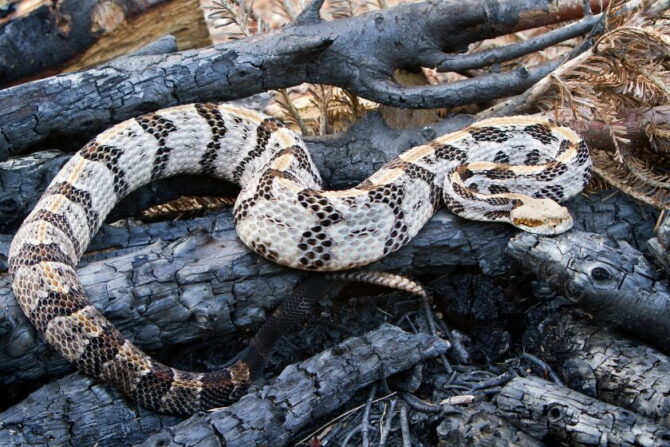
- Scientific name: Crotalus horridus
- Classification: Reptile
- Habitat: Forests, trees, hills, swamp
- Diet: Carnivore
- Conservation status: Least concern
The timber rattlesnake is one of the most venomous snakes in America and it can kill if threatened.
It is known for the dark zigzag pattern on the skin, very rough scale, and grows up to 3-7 ft in length.
Because these snakes don’t like cold, they tend to hibernate for about 7 months during the winter.
Rattlesnakes are known to be one of the deadliest animals in the United States with their big size and extremely venomous long fangs that can easily pierce flesh.
Their venom prevents wounds from closing and can cause symptoms like swelling, serious pain, bleeding, paralysis, and even death after entering the bloodstream. Get medical treatment immediately.
3. American Black Bear

- Scientific Name: Ursus americanus
- Classification: Mammal
- Habitat: Forest and mountains
- Diet: Omnivore
- Conservation Status: Least concern
Black bears are a subspecies of brown bears native to the North American continent.
They are classified as medium-sized bears, and their adult size varies depending on the region.
Black bears are omnivorous due to their diet consisting of both plants and animals.
These bears are solitary, but they have been known to associate in small family groups during the fall and winter.
Over Twenty-five fatal black bear attacks have occurred in North America in the last 20 years, with about 1.25 fatal attacks per year.
4. Portuguese Man O’War
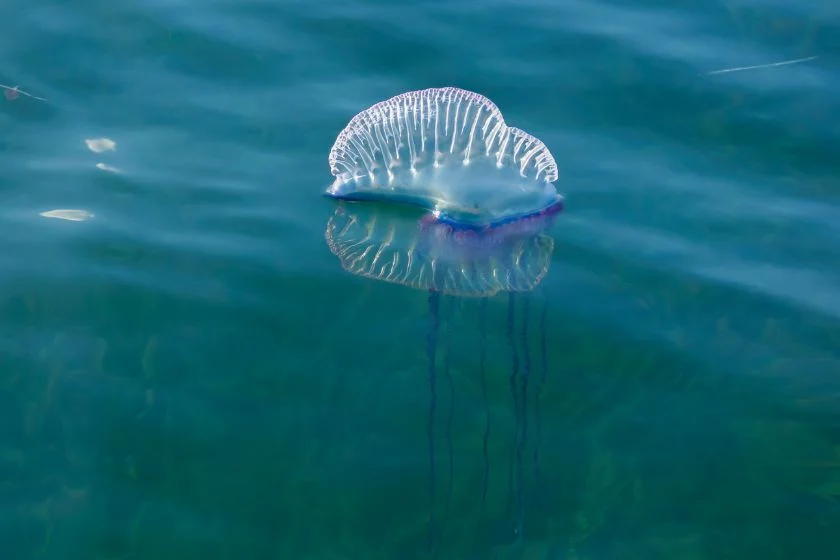
- Scientific name: Physalia physalis
- Classification: Invertebrates
- Habitat: Tropical waters, subtropical waters, seas, oceans
- Diet: Carnivores
- Conservation: Least concern
A Portuguese man o’ war is often mistaken for a jellyfish or a blue bottle because of its looks, but it is more dangerous than appears on the surface.
Its name was inspired by the 18th-century Portuguese-armed sailing ship as many believed that this jellyfish looked like the ship when viewed at full sail.
A very strange invertebrate, the Portuguese man o’ war is made up of a combination of organisms called zooids, where each zooid perform a particular function, and all zooids work together as a unit.
The extremely deadly invertebrate’s tentacles can sting and kill a fish. It is also powerful enough to kill a human.
A sting in the water can cause paralysis and sometimes lead to drowning.
Occasionally, these animals are found on beaches in Florida and other parts of the United States.
So, if you come across one of these invertebrates while taking a stroll on the beach, be sure to stay away.
5. Brown Recluse Spider
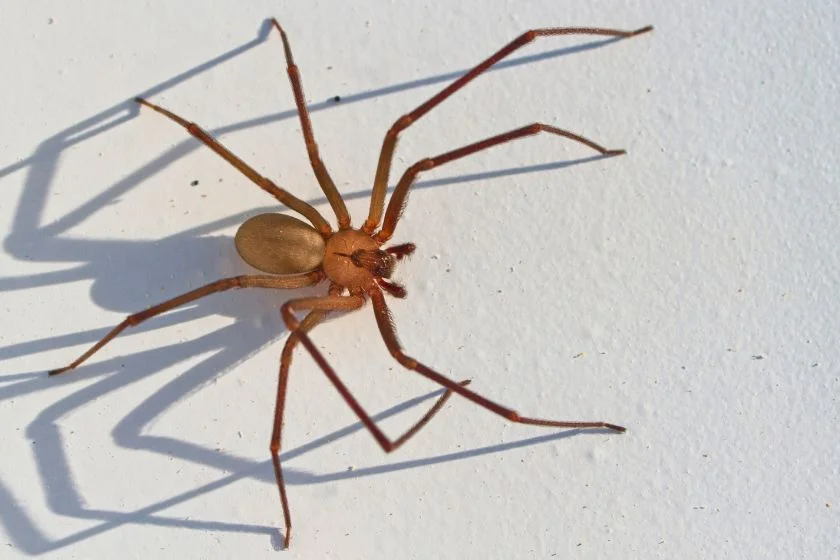
- Scientific name: Loxosceles reclusa
- Classification: Arachnid
- Habitat: Web
- Diet: Carnivores
- Conversation Status: Least concern
The recluse is also known as a fiddleback spider because the marking at the front part of its body is shaped like a violin.
It is native to many regions (including the United States) and is one of the most venomous arachnids in the United States.
A fun fact about these brown-colored spiders with varying shades is that when trapped by a predator or infected, they can cut off their limbs to escape death.
The brown recluse spider is a solitary animal and loves to be left alone in dark hidden parts of the house like abandoned shoes, dark corners of shelves, and other hidden places to avoid human presence and disturbance.
Its toxin contains a rare cell killer that destroys cell membranes, resulting in the death of tissues in the affected bite area and even death. If bitten, symptoms include;
- Headaches
- Vomiting
- Skin damage
- Muscle pain
- Death
If you get bit, seek medical treatment immediately. You can also prevent being bitten by avoiding these spiders.
6. Sting Rays
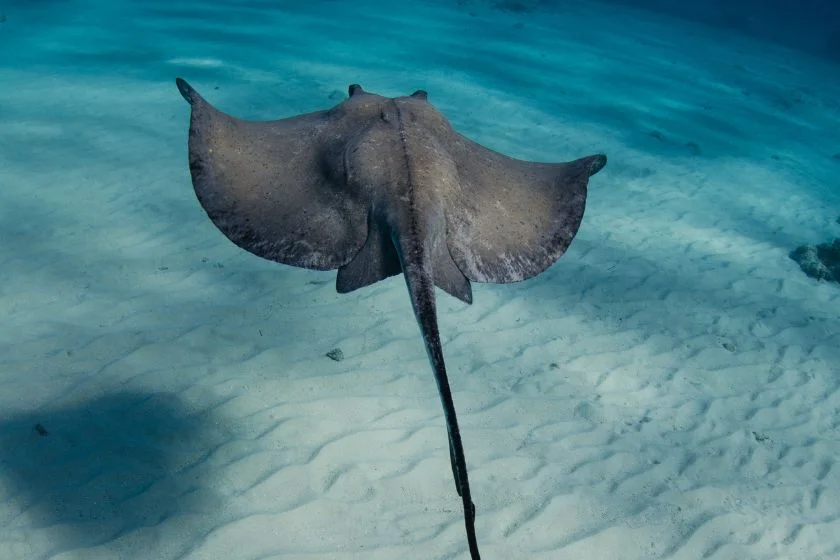
- Scientific name: Myliobatodei
- Classification: Fish
- Habitat: Freshwaters, shallow coastal waters, tropical waters
- Diet: Carnivores
- Conversation Status: Least concern
There are so many dangerous deep sea creatures throughout the oceans and beaches in the United States, and one of these is the Stingray.
The Stingray is a carpet-sized fish made of only tissues and no bones. It also has wide fins that are often regarded as wings.
These fishes have a defensive rope-like barbed tail called a stinger equipped with neutralizing venom that can paralyze its prey in water. This stinger is located at the base of its tail.
Though they seem gentle, they are dangerous and will sting when disturbed in their habitat or if they feel remotely threatened.
When bothered, the Stingray jabs its stinger into its victim. This causes convulsions, difficulty breathing, and ultimately death (by venom or drowning).
Although stingray attacks on humans are rare, they have been known to kill humans.
A Stingray was discovered responsible for the death of the famous crocodile hunter Steve Irwin in Australia in 2006.
He was stabbed almost a hundred times in the chest within seconds. Their notoriety increased since then.
The Stingray also has a high number of recorded deaths in the U.S. In 2006, a stingray flew out of the water and struck an 81-year-old man off the coast of Florida.
In 2008, also on the coast of Florida, a woman from Michigan was stabbed in the face by a stingray.
Stingrays are peaceful creatures and rarely attack humans, but if you come in contact with them, swim the other way quickly.
7. American Crocodile

- Scientific name: Crocodylus acutus
- Classification: Reptile
- Habitat: Lakes, rivers, wetlands, and saltwater
- Diet: Carnivore
- Conservation Status: Vulnerable
The American crocodile is mainly found in Florida. It is one of the largest and most dangerous reptiles in the United States.
Although crocodile attacks in the United States are rare, you can’t put it past them.
These reptiles can hide in plain sight, are known to be aggressive, and will attack with their razor-sharp teeth.
The latter easily tear through flesh. Crocodiles will attack if they feel slightly threatened, or even if they come across you and their prey instinct is activated.
Crocodiles are endangered in the United States so you may not come across one. However, there have been recorded cases of crocodile attacks.
In 2014, two swimmers were attacked by a crocodile in Florida and were dubbed the first victims to be attacked by a crocodile.
As nocturnal animals, they are mainly active at night. It’s best to avoid areas where there have been crocodile sightings at night.
8. American Alligator

- Scientific name: Alligator mississippiensis
- Classification: Reptile
- Habitat: Freshwaters, slow-moving rivers, marshes, and lakes
- Diet: Carnivore
- Conservation status: Least concern
The American alligator is a large reptile sometimes mistaken for a crocodile.
These gators weigh about 1,000 pounds and are less aggressive than their cousins the crocodiles.
They rarely strike humans but will do so if they feel threatened. As solitary animals, gators are territorial.
This makes them willing to attack and kill if the ‘enemy’ enters their territory. They can also attack if they are extremely hungry.
The main threat from an alligator is its bite, as it is known to possess one of the most powerful and deadliest jaw grips in the world.
Once a gator grabs its prey with its sharp teeth, the odds of being released are low. The teeth can cut through flesh like a knife and crush bones like shredders.
Once held, the alligator will drag its prey to the bottom of the river and drown it.
Because of how difficult escaping its grip when attacked by a gator is, the best strategy is to attack its eyes or throat because it will be stunned momentarily and release its grip.
You should stay away from the American alligator to avoid stories that touch.
9. Gila Monster

- Scientific name: Heloderma suspectum
- Classification: Reptile
- Habitat: Rocky regions, deserts, grasslands, arroyos, washes
- Diet: Carnivores
- Conversation Status: Near Threatened
We generally don’t consider lizards as dangerous, let alone vicious.
However, these colorful-looking, beautiful and eye-catching lizards are highly dangerous and venomous.
They are mainly found in the southwestern region of the United States.
These lizards can spit venom and inject it into the bloodstream by either using their fangs or biting and chewing it into their victims.
The Gila monster bite can be excruciating, but it hardly causes death, and there has been no death report in the United States. Its venom is known to cause the following symptoms.
- Weakness
- Low blood pressure
- Intense pain
- Dizziness
- Vomiting
- Swelling
- A great deal of pain
Thankfully, the Gila monster moves slowly, so it will be easy to escape if you come across one. However, don’t underestimate the havoc this creature can cause.
10. Wolf
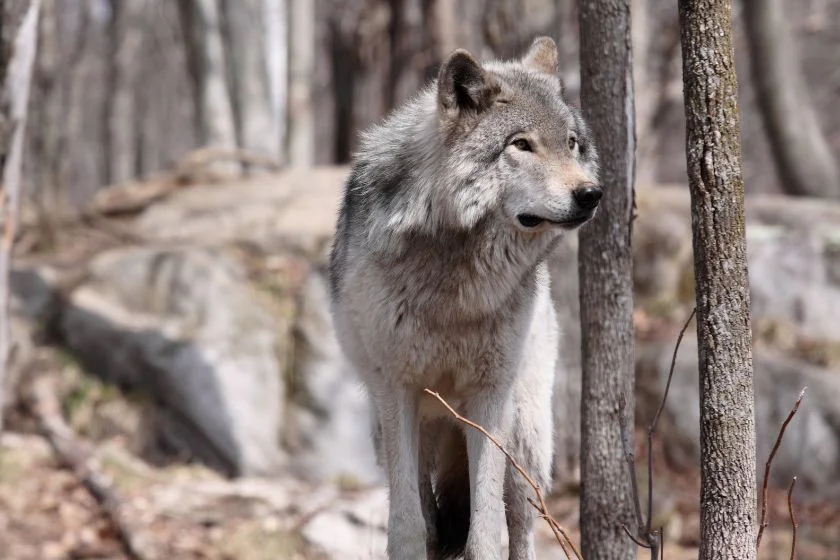
- Scientific Name: Canis lupus
- Classification: Mammal
- Habitat: Forest, Desert, Grassland
- Diet: Carnivore
- Conservation status: Endangered
These wolves are the biggest wild dogs in North America.
Although they are listed as a species that can be found across the continent, only five subspecies of gray wolves can be found living in North America today.
Wolves were once widely distributed across North America, but human activities and development led to their near-total extermination in the United States.
Gray wolves were scheduled to be eliminated from the United States under the Endangered Act 1970.
Still, environmentalist lawsuits ultimately led to the wolf population being listed as Threatened rather than Endangered.
Wolves use various methods to capture their prey, including ambushing it, pouncing on it while it sleeps, and trapping it in a snare.
They are wary of humans and don’t attack on a whim, but a pack can easily pose a danger to campers.
11. Diamondback Snakes
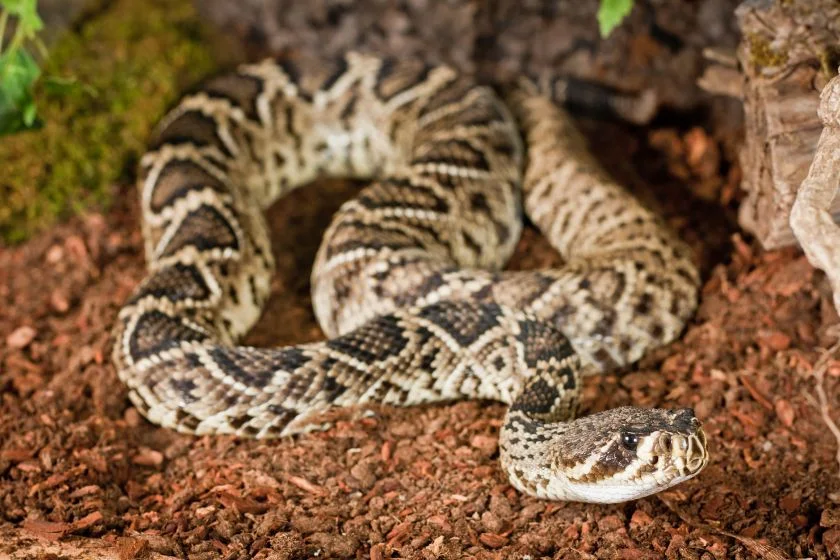
- Scientific name: Crotalusatrox
- Classification: Reptile
- Habitat: Under vegetation, rocks, debris
- Diet: Carnivore
- Conservation status: Least Concern
Diamondbacks are one of the most infamous reptiles in the United States. They are a member of the copperhead family.
Special detectors on each side of their head detect heat and give them a thermal image of everything around them.
You can also feel their presence by listening to the clattering sound they make when they are nearby.
These snakes are not aggressive but will attack if cornered. They don’t rattle all the time but will remain silent and hidden.
They are a little more unsettled than any other snake species and will attack whenever possible.
However, if you back off and give them space, they will also avoid you.
12. Bees, Hornets, and Wasps

- Scientific name: Anthophila; Vespa; Vespidae
- Classification: Insects
- Habitat: Garden, woodland
- Diet: Herbivore
- Conservation status: Vulnerable
While some people know the dangers of bees, others don’t think bees are very dangerous. They might even see them as harmless bugs.
However, hornets, wasps, and bees are amongst the most dangerous animals in the United States. They attack more Americans each year than any other creature.
The CDC reports confirmed that bees, hornets, and wasps caused the death of about 1,109 individuals between 2000 and 2017.
A sting from these insects is very agonizing, so it’s best to avoid them when seen.
13. Black Widow Spider

- Scientific name: Latrodectus
- Classification: Invertebrates
- Habitat: Holes, small trees
- Diet: Carnivore
- Conservation status: Least concern
The black widow is also called the shoe-button spider. It prefers temperate habitats and can be found on many continents, apart from Antarctica.
The female black widow stings while the males don’t. The male usually becomes food for the female after mating.
The black widow, though small, is not entirely harmless.
Due to the neurotoxin in its venom, its sting can lead to respiratory problems, hypertension, and muscular pain.
If you suspect that you’ve been stung, seek medical help immediately.
14. Scorpions

- Scientific name: Scorpions
- Classification: Arthropod
- Habitat: Desert, grassland, savanna, tropical jungles
- Diet: Carnivore
- Conservation status: Least Concern
The Species of scorpions found in the United States are dangerous. They sting with their tails and inject you with venom, which can be very unpleasant.
However, they rarely sting people and prefer to eat other insects or small animals like mice.
If you’re outside and come across one of these creatures, it won’t attack you unless it feels threatened. If a scorpion does sting you, seek medical attention immediately.
15. Sharks
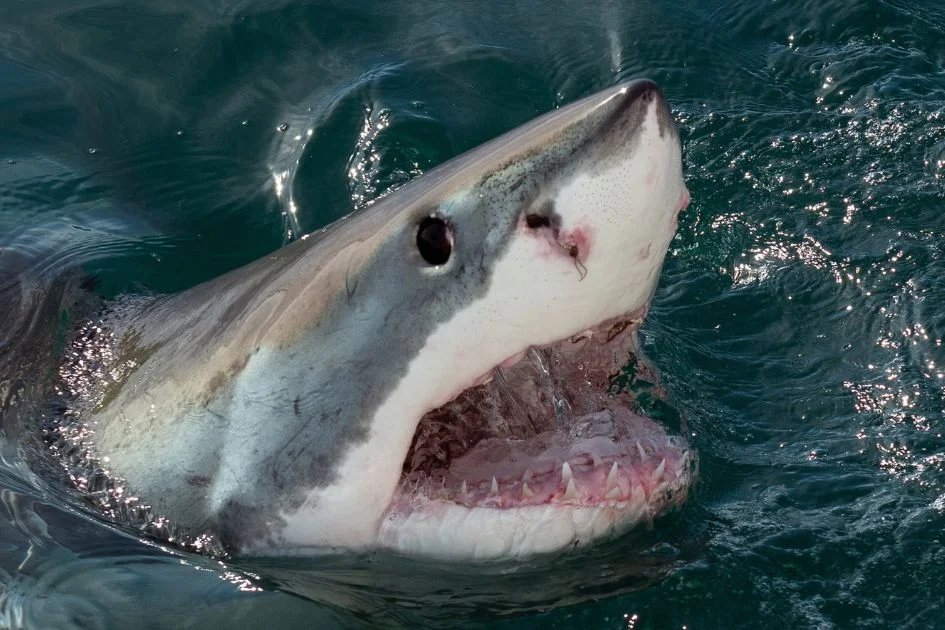
- Scientific name: Selachimorpha
- Classification: Fish
- Habitat: Oceans, large bodies of water
- Diet: Carnivore
- Conservation status: Endangered
Sharks are the apex predators of the sea, and it shouldn’t come as a surprise that they are considered dangerous.
There are many species of sharks in the United States, including the great white shark.
Shark attacks in the United States are rare, but they do happen.
According to statistics from the International Shark Attack File, 82 unprovoked shark attacks were reported in the U.S. in 2018 alone.
Of those attacks, 64% occurred in Florida and California, with three shark-human interaction incidents.
The most common shark injuries were mutilations (42%) and puncture wounds (37%). One fatality was reported in 2018.
United States Wildlife Safety Tips
Mentions of sharks, scorpions, and spiders may seem scary, but it’s not all bad news.
There are safety tips you can follow to make the best of your wildlife exploration, whether you’re a local or a visitor.
They include:
Swim in safe areas
Avoid areas where sharks have been spotted if you’re swimming or surfing. If you see one near you, stay calm and swim away as calmly as possible.
If this is impossible—for example, if there’s a large school of fish nearby—then splash around loudly so the shark knows that there’s something alive nearby and moves away from you.
Be on the lookout
If you’re exploring an area that’s alligator-infested, always be on the lookout for them and avoid getting too close to water sources where they might be hiding.
If an alligator attacks you while swimming or wading through shallow water (less than 6 feet deep), do not struggle with it.
Instead, stay calm and swim away as quickly as possible.
Avoid bees by avoiding flowers
Bees are the next most common dangerous animals you’ll meet out there.
The best way to avoid getting stung by a bee is by avoiding flowers (which attract them) and wearing long sleeves and pants outdoors during warmer months (when bees are most active).
Don’t get too close to animals (including bison)
Don’t go near bison unless they’re in a zoo or park. They will charge at you if they feel threatened by your presence, smell food or blood.
Don’t pet animals
Never try to pet raccoons or wolves because they could attack if frightened or startled by your presence.
If one comes near you, leave the area immediately, so it doesn’t think it’s allowed around humans more than necessary.
Animals can be overprotective of their babies
Don’t approach bears unless you are sure they are deep in sleep—they might wake up suddenly and attack out of self-defense/protection from perceived threats (like firecrackers going off nearby).
Also, don’t be near them if they are with babies.
Frequently Asked Questions
Which wild animal kills the most in the United States?
The deer is responsible for the most kills in the United States. Statistically, based on data from the CDC, these calm-looking, gentle and cute herbivores cause the deaths of over 120 people yearly, which is more than any other animal in the United States.
Which animal is the most venomous in the United States?
Surprisingly, the most vicious animal in the United States is not the timber rattlesnake or any specie of snake but rather the Arizona black scorpion native to the southeastern part of America.
Are there lions in the United States?
Sadly, there are no lions in the United States. The American lion lived in caves in the U.S. over 11,000 years ago but is now extinct in America.
Conclusion
All animals have their place in nature, and we must treat them respectfully.
Some of these most dangerous animals in America can be deadly if you get too close, but for the most part, they are either trying to survive or defend themselves.
Therefore, as much as possible, please stay away from them. Let our survival tips be a good guide.




